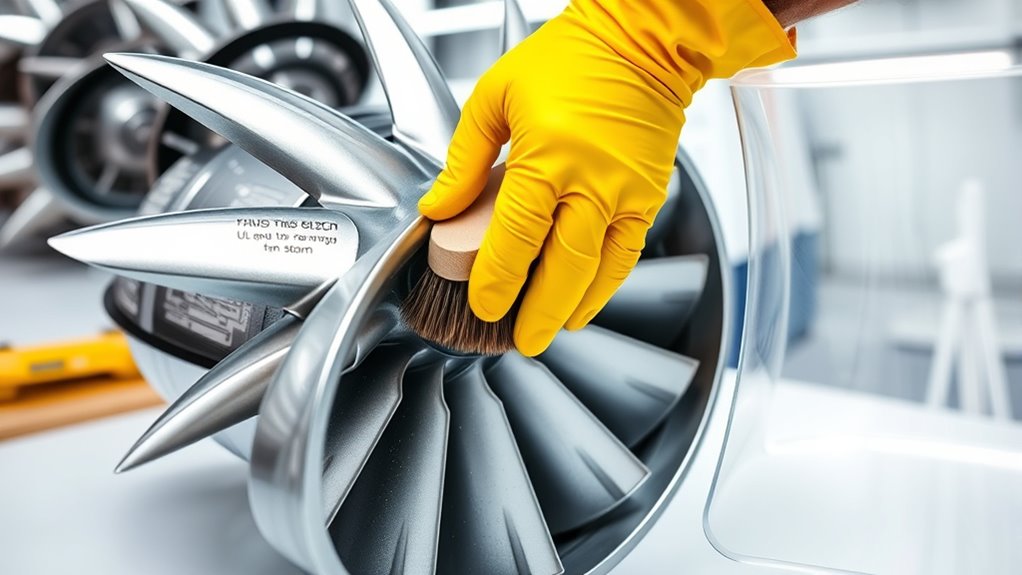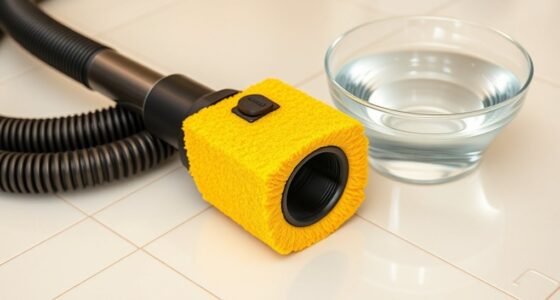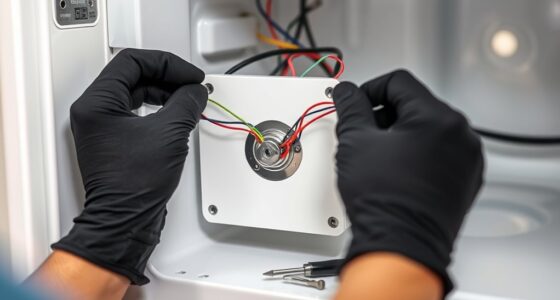To restore suction by cleaning the vacuum fan blades safely, first unplug your vacuum and prepare a clutter-free workspace. Remove the cover carefully, then inspect the blades for dust, debris, or damage. Use a soft brush or cloth to gently clean and remove buildup. Check for cracks or bent blades; if everything looks good, reassemble and test your vacuum. Continuing with these steps will help you keep your vacuum running smoothly and efficiently.
Key Takeaways
- Unplug the vacuum and ensure the power is off before accessing the fan blades to prevent electrical hazards.
- Remove the vacuum cover or dustbin carefully, following manufacturer instructions, to access the fan assembly.
- Gently clean dust and debris from the fan blades using a soft brush or damp cloth to avoid damage.
- Inspect the blades for cracks, chips, or misalignment, and address any damage promptly to restore optimal airflow.
- Reassemble the vacuum securely, then test suction to confirm cleaning has effectively restored performance.
Gather Your Tools and Prepare the Work Area

Before you begin cleaning the vacuum fan blades, you need to gather all the necessary tools and set up a safe, organized work area. Start with a screwdriver suitable for your vacuum model, a soft brush or cloth, and a container for small parts. Having these tools ready helps streamline the process and prevents unnecessary delays. Make sure your workspace is well-lit, flat, and free of clutter to avoid accidents. Proper setup is essential for effective vacuum filter maintenance and troubleshooting suction issues. Keep the vacuum unplugged during preparation to ensure safety. Clearing the area allows you to focus on cleaning the fan blades thoroughly, removing dust and debris that may hinder airflow. An organized workspace makes the entire process safer, faster, and more efficient. Additionally, understanding vetted privacy policies and cookie management options can help you protect your personal information while working online.
Unplug the Vacuum and Safety Precautions

To guarantee your safety, unplug the vacuum before starting any cleaning or maintenance work. This step is essential to prevent electrical shocks and ensure overall vacuum safety. Always disconnect the appliance from the power source before handling internal parts. Remember, even when the vacuum is off, residual electricity could pose a risk. Additionally, familiarize yourself with the safety precautions specific to your vacuum model to prevent damage or injury.
Before proceeding, consider these safety precautions:
- Confirm the vacuum is fully unplugged from the electrical outlet.
- Handle the cord carefully to avoid damage.
- Avoid touching internal components without proper tools.
- Work in a dry, well-lit area to prevent accidents.
Taking these precautions safeguards you from electrical hazards and ensures a safe cleaning process. Never bypass the unplugging step, as it’s critical for safe maintenance.
Access the Fan Blades by Removing the Cover
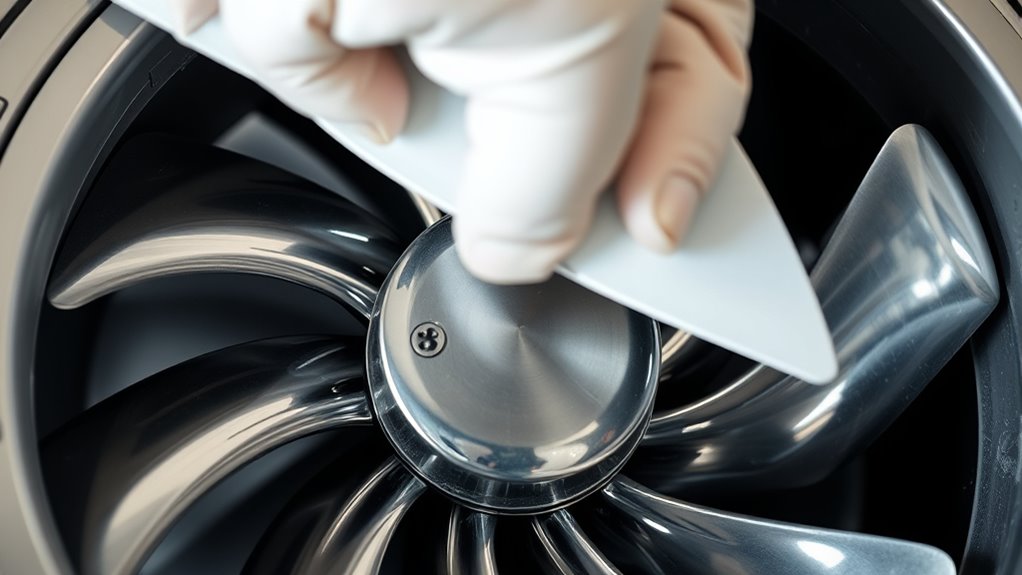
Removing the cover is the first step to accessing the fan blades. To do this, identify the type of cover your vacuum has, which may be plastic or metal, depending on the model. Use appropriate cover removal techniques, such as unscrewing bolts or clips, to avoid damaging the fan or surrounding parts. Be gentle when prying off the cover, especially if it’s stuck due to dust or debris buildup. Once removed, you’ll see the fan blades, often made of plastic or metal. Carefully detach the cover, ensuring you don’t bend or crack it. This step grants you clear access to the fan blades, making it easier to clean and restore your vacuum’s suction power effectively and safely. Additionally, understanding the fan blade design can help you identify potential issues more accurately during cleaning.
Inspect the Fan Blades for Dust and Debris

Since dust and debris often accumulate on the fan blades over time, inspecting them thoroughly is essential to restore your vacuum’s suction. Look for signs of dust accumulation that can hinder airflow and reduce performance. Check the fan blade alignment to guarantee they’re properly positioned; misaligned blades can cause vibrations and inefficiency. Examine the blades closely for any buildup or damage that might affect operation. Pay attention to these key points:
- Signs of dust buildup affecting airflow
- Proper fan blade alignment
- Damage or cracks on blades
- Debris lodged between blades or in the housing
Addressing these issues ensures your fan operates smoothly, maintaining ideal suction power. Regular inspections help prevent further damage and keep your vacuum functioning at its best. Additionally, understanding the role of contrast ratio can help you optimize your home cinema setup for an immersive viewing experience.
Remove Dust and Debris From the Fan Blades

First, turn off your vacuum to guarantee safety. Then, access the fan area carefully, following your model’s instructions. Finally, gently remove dust and debris from the blades without applying excessive force. Incorporating professional equipment can help ensure a thorough and safe cleaning process.
Power Off Vacuum
Before you begin cleaning the fan blades, make sure the vacuum is powered off to prevent any accidents or electrical issues. Unplug the device completely, especially if it’s corded, or turn off the power switch for cordless models. This step is essential for safe battery maintenance and to avoid accidental activation. Once powered down, check the filter condition and replace it if needed, ensuring ideal airflow. Also, inspect the vacuum for dust buildup that could interfere with the fan. Properly shutting off the vacuum prevents electrical hazards and protects your components. Remember, a well-maintained vacuum with clean fan blades runs more efficiently, maintaining suction power. Regular cleaning of fan blades can help prevent dust buildup, which is crucial for optimal performance. Always prioritize safety before proceeding to clean or perform maintenance tasks on your vacuum.
Access Fan Area
How can you effectively access the fan area to remove dust and debris? First, unplug your vacuum to guarantee safety. Remove the vacuum’s outer cover or dustbin to expose the internal components. Locate the fan blades, which are typically behind the motor housing. For fan blade cleaning, use a soft brush or a damp cloth to gently wipe away dust buildup. Avoid using harsh chemicals that could damage plastic parts. During vacuum maintenance, check for any accumulated debris on the blades or surrounding areas. If needed, carefully detach the fan assembly following your manufacturer’s instructions. Proper access allows thorough cleaning, preventing dust from hindering airflow. Regularly inspecting and cleaning the fan blades helps restore suction and keeps your vacuum operating efficiently. Being aware of personal debt forgiveness bills can also offer financial relief that may support your maintenance needs.
Remove Debris Carefully
To effectively remove dust and debris from the fan blades, gently grasp a soft brush or a damp cloth and carefully wipe away any buildup. This prevents dust accumulation that can impair performance. Take your time to guarantee all debris is removed without disturbing the fan blade alignment. Proper cleaning sustains ideal airflow and prevents uneven wear. Be cautious to avoid applying excessive pressure, which might bend or misalign the blades. Regularly inspecting and cleaning the blades helps preserve the vacuum’s suction power. Use gentle, deliberate strokes to dislodge stubborn dust or debris. Keep track of any misalignment issues that could worsen with dirt buildup. Maintaining clean, well-aligned fan blades ensures your vacuum continues to operate efficiently and safely. Additionally, understanding the benefits of regular maintenance can help you keep your vacuum functioning at its best for longer periods.
Clean the Fan Blades With a Soft Brush or Cloth
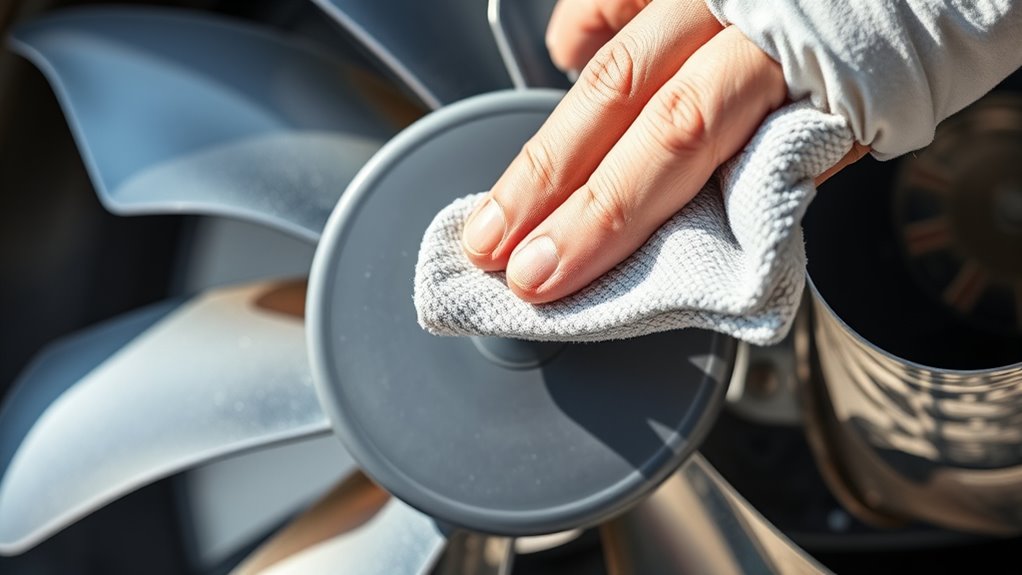
Cleaning the fan blades with a soft brush or cloth is an effective way to remove dust and debris that can hinder suction. Dust accumulation on the blades reduces airflow, making your vacuum less efficient. Using soft cleaning tools ensures you won’t damage the blades or dislodge any delicate parts. Gently brush or wipe the blades, focusing on areas with visible dust buildup. Take your time to reach all angles without applying too much pressure. A microfiber cloth or a soft-bristled brush works best for this task, easily lifting dust without scratching surfaces. Regularly cleaning the fan blades with soft tools helps maintain vacuum cleaner performance metrics such as suction power and airflow, extending your vacuum’s life and improving its performance.
Check for Damage or Wear on the Fan Blades

Take a close look at your fan blades for any signs of damage or wear. Look for cracks, chips, or bent blades that could be affecting performance. Noticing these issues early helps you decide if repairs or replacements are necessary. Regular inspection of your equipment can prevent further damage and ensure optimal operation. Aquatic exercise can also promote better circulation, which is beneficial when maintaining your equipment.
Visual Inspection Tips
When inspecting vacuum fan blades for damage or wear, it’s essential to look closely at their edges and surfaces. Check for signs of dust accumulation, which can hinder performance, and ensure the blades are properly aligned to prevent imbalance. Look for cracks, chips, or warping that could compromise the blades’ function. Maintaining a clean, dust-free surface helps identify issues early. Also, verify that each blade is securely attached and evenly spaced. Proper blade alignment ensures smooth operation and reduces strain on the motor. Regular visual checks can prevent more severe damage and restore suction efficiency. Keep these tips in mind to spot potential problems before they escalate, guaranteeing your vacuum runs at its best.
Signs of Damage
Inspecting your vacuum fan blades for damage is a vital step in maintaining essential suction. Fan blade damage can cause decreased performance and louder fan noise indicators. Look for cracks, chips, or bent blades, which often result from debris or impact. Damaged blades may wobble or spin unevenly, leading to unusual vibrations. Fan noise indicators, like rattling or squealing sounds, can also signal wear or imbalance. If you notice these signs, it’s imperative to address the issue promptly. Continuing to use a vacuum with damaged fan blades can worsen the problem or damage other components. Regularly inspecting for these signs guarantees your vacuum operates efficiently and helps you catch issues early before costly repairs are needed.
Reassemble the Vacuum Carefully

Careful reassembly is essential to guarantee your vacuum functions properly after cleaning the fan blades. During vacuum assembly, ensure all parts are correctly aligned and securely fitted to avoid air leaks or mechanical issues. When reinstalling parts, double-check that each component clicks into place and that screws are tightened without over-tightening, which could damage plastic parts. Proper parts reinstallation maintains the vacuum’s suction power and prevents future malfunctions. Take your time to verify that the fan blades are positioned correctly and that no tools or debris remain inside the unit. Keep track of all screws and small components to prevent loss. A meticulous approach during reassembly ensures your vacuum will operate smoothly and efficiently.
Test the Vacuum for Improved Suction
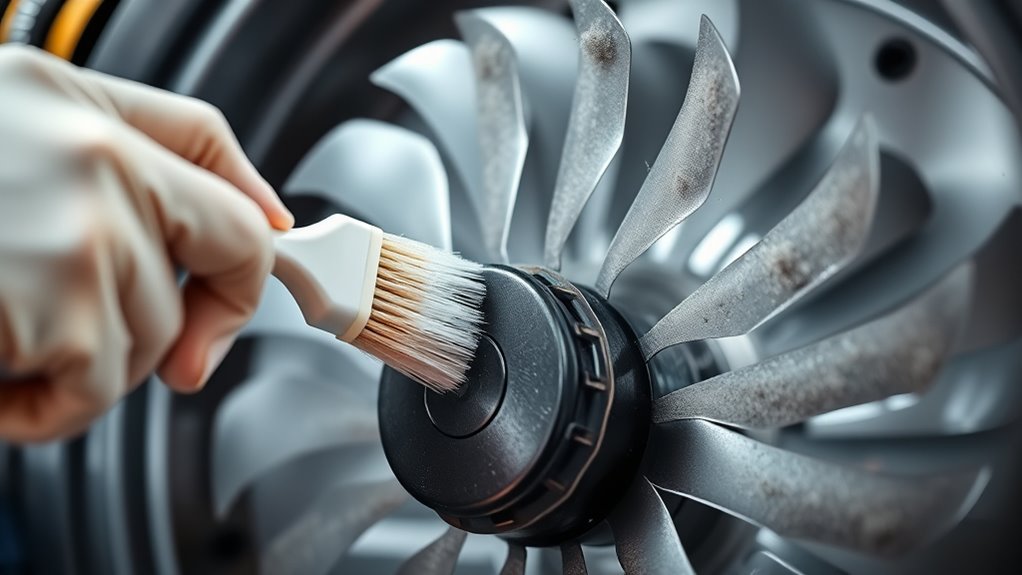
After reassembling your vacuum, it’s important to test its suction to make certain the cleaning performance has improved. Turn on the vacuum and hold a lightweight object, like a piece of paper or a tissue, near the nozzle or intake port. If the object is pulled in firmly, your suction is strong. Check the vacuum filter for signs of clogging or dirt buildup, as a clean filter boosts suction. If the filter appears dirty, replace it following the manufacturer’s instructions. Additionally, inspect the brush roll; if it’s worn or tangled, replace the brush to ensure better airflow and cleaning efficiency. Testing the vacuum after these steps confirms whether the fan blade cleaning and filter maintenance have successfully restored suction power.
Maintain Regular Cleaning to Prevent Future Buildup
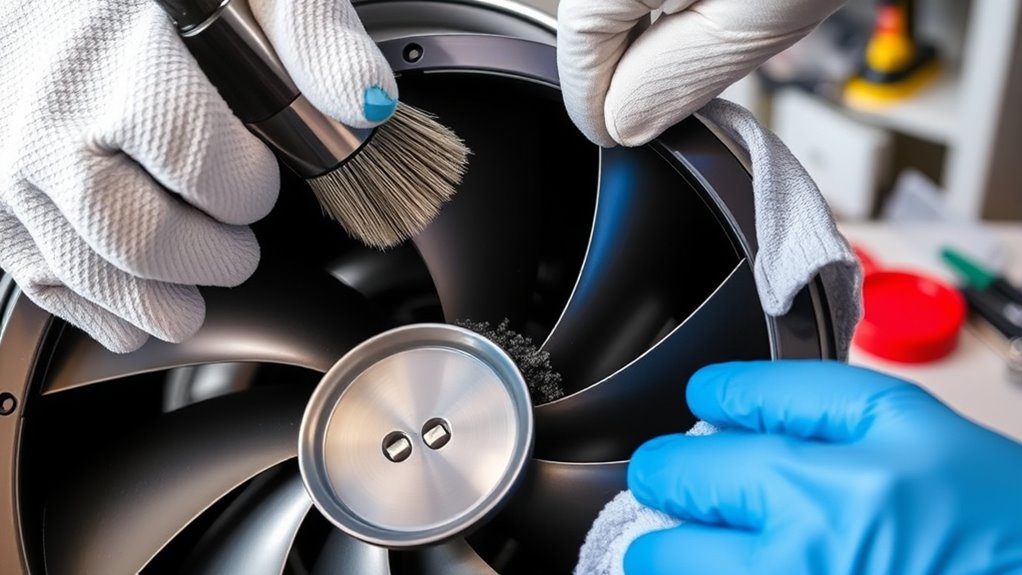
Regularly cleaning your vacuum components helps prevent dust and debris from accumulating, which can hinder performance over time. Consistent maintenance ensures peak air filtration, reducing strain on the motor and prolonging its lifespan. To stay ahead of buildup, consider these practices:
Regular cleaning prevents dust buildup, ensuring optimal vacuum performance and longer motor lifespan.
- Check and replace air filters regularly for efficient air filtration.
- Clean fan blades and vents to prevent dust accumulation.
- Inspect and maintain the motor to avoid overheating.
- Use compressed air to clear dust from internal parts safely.
Frequently Asked Questions
How Often Should I Clean My Vacuum Fan Blades?
You should clean your vacuum fan blades during regular vacuum maintenance, ideally every three to six months, depending on usage. Regular fan blade inspection helps prevent dust build-up that can reduce suction. If you notice decreased performance or strange noises, it’s a good sign to cleanse the blades sooner. Keeping your fan blades clean ensures your vacuum runs efficiently and lasts longer, so make it part of your routine maintenance.
Can I Use Household Cleaning Products on the Fan Blades?
Did you know that improper cleaning can reduce your vacuum’s lifespan? When it comes to fan blade maintenance, avoid using household cleaners on the fan blades. These products can damage sensitive parts or leave residues that hinder performance. Instead, opt for a damp cloth or a mild soap solution. This keeps your vacuum running efficiently and extends its life without risking damage from harsh household cleaners.
What Signs Indicate Fan Blade Damage Beyond Dust Buildup?
You’ll notice fan blade damage if your vacuum shows signs like fan imbalance, where the motor vibrates or feels unsteady, or if you hear unusual noises such as screeching or rattling. These symptoms suggest that the blades might be bent, cracked, or broken beyond dust buildup. Regularly inspecting the blades can help you catch damage early, preventing further motor issues and maintaining ideal suction performance.
Is It Necessary to Replace the Fan Blades Periodically?
You don’t need to replace fan blades periodically unless they’re damaged or worn out. Fan blade materials like plastic or metal can last a long time, but if you notice cracks, chips, or imbalance, replacement is necessary. Keep in mind, the replacement cost varies depending on the vacuum model. Regular inspection helps you decide when a replacement is worth it, ensuring your vacuum maintains peak suction power.
Are There Specific Safety Gear Recommendations for This Cleaning Process?
Imagine the risk of dust and debris flying into your eyes or onto your skin, risking irritation or injury. For this cleaning, you should wear protective gloves to shield your hands and eye protection like goggles to prevent particles from reaching your eyes. These safety gear recommendations are simple but essential, ensuring you carry out the task safely. Don’t skip these protections—they keep you safe while restoring your vacuum’s suction effectively.
Conclusion
By regularly giving your vacuum a gentle refresh, you keep it performing at its best and guarantee it’s always ready to handle your cleaning needs. A simple, careful care routine can work wonders, quietly restoring its strength without much fuss. Think of it as a little tune-up for your trusty helper—keeping everything running smoothly and quietly in the background, so your home stays fresh and inviting with minimal effort.

